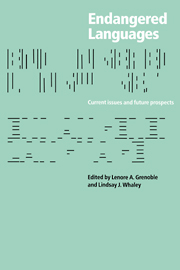Book contents
- Frontmatter
- Contents
- Preface
- List of abbreviations and symbols
- Part I General issues
- Part II Language-community responses
- Part III What is lost: language diversity
- Part IV Mechanisms of language loss
- 11 Impact of language variation and accommodation theory on language maintenance: an analysis of Shaba Swahili
- 12 A way to dusty death: the Matrix Language turnover hypothesis
- 13 Copper Island Aleut: a case of language “resurrection”
- Appendix
- References
- Index of languages
- Index of names
- General index
12 - A way to dusty death: the Matrix Language turnover hypothesis
Published online by Cambridge University Press: 05 June 2012
- Frontmatter
- Contents
- Preface
- List of abbreviations and symbols
- Part I General issues
- Part II Language-community responses
- Part III What is lost: language diversity
- Part IV Mechanisms of language loss
- 11 Impact of language variation and accommodation theory on language maintenance: an analysis of Shaba Swahili
- 12 A way to dusty death: the Matrix Language turnover hypothesis
- 13 Copper Island Aleut: a case of language “resurrection”
- Appendix
- References
- Index of languages
- Index of names
- General index
Summary
Introduction
This chapter proposes a set of predictions to explain the general morphosyntactic structural outlines found across all types of bilingual speech. Bilingual speech is defined as showing either morphemes or lexical structure, or both, from two or more languages. One encounters bilingual speech most typically in code-switching by proficient bilinguals, but not all language-contact situations are so viable or capable of sustaining themselves. Specifically, the paper accounts for cases of what have been called structural borrowing, especially in relation to language attrition. Languages can sustain structural incursions and remain robust, but the taking in of alien inflections and function words is often a step leading to language attrition and language death. This is not to say, however, that all endangered languages in their late stages show structural borrowing; that is, all the following arguments do not apply to all endangered languages and certainly not to the speech of final fluent speakers.
Assumptions and claims of the proposed model
What makes the model presented here different from previous discussions of structural borrowing in the literature are these claims:
Heavy cultural contact is a necessary precondition for structural incursions of one language into another (Thomason and Kaufman 1988), but contact itself obviously is not the structural mechanism involved. The hypothesis developed here is that the actual mechanism which sets the stage for structural change is a turnover (from one language to another) in the role of the Matrix Language (i.e. morphosyntactic frame builder) in bilingual speech. The Matrix Language (ML) as a theoretical construct is discussed below. […]
- Type
- Chapter
- Information
- Endangered LanguagesLanguage Loss and Community Response, pp. 289 - 316Publisher: Cambridge University PressPrint publication year: 1998
- 44
- Cited by



